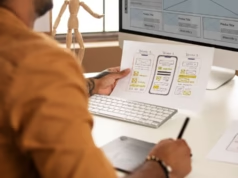A good website design proposal is crucial for securing client projects. It outlines project scope, timelines, and pricing, ensuring mutual understanding.
Clear proposals showcase expertise, build client trust, and set expectations for successful collaboration.
They serve as a roadmap for both parties, guiding the project toward a successful outcome.
Creating a winning website design proposal requires a mix of professionalism, creativity, and strategic thinking.
Find out these useful tips by the best website design company in Delhi –
Understand the Client’s Needs
Start by thoroughly analysing the client’s requirements, preferences, target audience, and business goals.
Customize your proposal to target these specific needs and concerns.
It’s important to ask questions and listen carefully to what they say.
What kind of website do they need? Who will visit it? What do they want visitors to do?
By learning about their business and goals, you can make sure your proposal matches what they’re looking for.
This helps you show that you understand them and can give them what they need, making them more likely to choose you for the project.
Highlight Your Expertise
Showcase your relevant experience, skills, and past successes in website design.
Provide examples of your work that align closely with the client’s industry or style preferences.
This means sharing examples of websites you’ve created before and talking about how you helped past clients.
It’s like saying, “Look at what I’ve done and how good I am at it!”
This helps the client see that you know what you’re doing and can do a great job for them too.
Gather your best work examples and talk about them in your proposal to impress the client and show them why they should pick you for their website project.
Clear Project Scope
Clearly define the scope of the project, including deliverables, milestones, timelines, and budget estimates.
Ensure that both you and the client have a mutual understanding of what will be included in the project.
It’s like drawing a map before going on a trip, showing every stop along the way.
In the proposal, you need to explain what you’ll create for the client, when you’ll finish each part, and how much it’ll cost.
This helps both you and the client understand what to expect.
It’s like making a promise, so everyone knows what they’re agreeing to.
This way, there’s less chance of confusion or disagreement later on, and everyone can work together smoothly.
Personalized Approach
Avoid using generic templates. Instead, customize your proposal to fit the client’s needs.
Personalize your proposal by addressing the client by name and referencing specific details from your discussions or their website.
Address them by name and mention specific details from your conversations or their website.
This shows that you’ve paid attention and genuinely care about their project.
It helps to build trust and rapport with the client, making them more likely to choose you for the job.
Personalizing your proposal sets you apart from competitors and shows that you’re invested in creating a tailored solution for their business.
Value Proposition
Clearly communicate the value proposition of your proposed design solution.
Explain how your design approach will help the client achieve their business objectives, such as increasing conversions, improving user experience, or enhancing brand visibility.
Explain how your website design proposal will benefit the client’s business.
You need to clearly describe how your design approach will help them reach their goals, like getting more customers or boosting their brand.
If your design focuses on making the website easy to use, you can explain how this will increase the chances of visitors becoming customers.
Essentially, you’re showing the client the positive impact your design will have on their business.
It helps them see the value in choosing you for the project.
Detailed Pricing and Payment Terms
Provide a detailed breakdown of your pricing structure, including any optional add-ons or ongoing maintenance services.
Be transparent about payment terms, such as deposit requirements and milestone payments.
You should break down the prices clearly, showing what each part of the project costs.
If you offer extra services like ongoing maintenance, make sure to include those costs too.
Also, tell the client when they need to pay you, like if they need to give a deposit upfront or pay in instalments as the work progresses.
Being transparent about pricing and payment terms helps both you and the client understand what to expect and avoid any misunderstandings.
Timeline and Milestones
Present a realistic timeline for the project, outlining key milestones and deadlines.
Clearly indicate when the client can expect to see progress and provide opportunities for feedback and revisions.
You need to tell the client how long it will take to finish the website and what important things will happen along the way.
This includes setting specific dates for when different parts of the website will be done.
You might say the design will be finished by a certain date, then coding by another.
These dates are called milestones.
By showing the client this plan, they can see the progress and know when they can give feedback or ask for changes.
It helps everyone stay on track and makes sure the project finishes on time.
Responsive Design and SEO
Emphasize the importance of responsive design and search engine optimization (SEO) in today’s digital landscape.
Explain how your design will adapt seamlessly to different devices and browsers and how it will be optimized for search engine visibility.
You should make websites that work well on all devices and show up high in online searches.
This means designing websites so they look good and function properly on phones, tablets, and computers.
It also involves making sure the website shows up near the top when people search for related topics on search engines like Google.
By doing this just like the best digital marketing institute in GTB Nagar Delhi, the website can reach more people and be easier to use.
It is important for attracting visitors and keeping them interested in what the website offers.
Client Involvement and Collaboration
Encourage client involvement throughout the design process.
Highlight opportunities for collaboration, such as design workshops, feedback sessions, or user testing phases.
Invite them to share their thoughts, ideas, and feedback throughout the process.
This collaboration helps ensure that the final website reflects their vision and goals.
It could involve meetings where we discuss design options or test out website features together.
By working closely with the client, we can create a website that truly meets their needs and delights their audience.
This approach creates a sense of partnership and leads to a better end result that everyone is happy with.
Call to Action
Conclude your proposal with a clear call to action, inviting the client to move forward with the project.
Provide contact information and encourage them to reach out with any questions or concerns.
It urges you to wrap up your proposal with a clear invitation for the client to take action.
This means ending your proposal with a friendly prompt, like asking them to get in touch to discuss next steps or to ask any questions they may have.
By including your contact details and encouraging them to reach out, you’re making it easy for the client to move forward with the project.
It’s like extending a welcoming hand, inviting them to engage with you further.
It shows them that you’re ready and available to help bring their website design vision to life.







